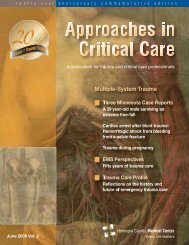Pediatric Trauma - Hennepin County Medical Center
Pediatric Trauma - Hennepin County Medical Center
Pediatric Trauma - Hennepin County Medical Center
You also want an ePaper? Increase the reach of your titles
YUMPU automatically turns print PDFs into web optimized ePapers that Google loves.
Case Reports<br />
Multiple classification systems for pelvic fractures<br />
exist, however most crucial is differentiating a stable<br />
vs. unstable pelvic fracture. Stable pelvis fractures<br />
include isolated iliac wing fractures and isolated<br />
fractures of the anterior pelvic ring, such as pubic<br />
rami fractures. Unstable fractures are those that<br />
involve the anterior and/or posterior sacroiliac<br />
ligaments of either or both sacroiliac joints, or vertical<br />
sacral fractures, and may result in pubic symphysis<br />
or sacroiliac diastasis. Significant hemorrhage<br />
generally is seen with unstable fractures and arises<br />
from the venous plexus immediately anterior to the<br />
sacrum, from cancellous bone edges, and from<br />
branches of the internal iliac artery. Measures to<br />
tamponade this hemorrhage include minimizing<br />
pelvic movement, pelvic wrapping, external fixation,<br />
internal packing, angiography with embolization, and<br />
possibly aortic balloon occlusion.<br />
Pelvic wrapping is most effective when there is<br />
sacroiliac or pubic symphysis diastasis without<br />
significant vertical displacement or acetabular fractures.<br />
Commercial pelvic binders may be utilized or a sheet<br />
wrapped low across the pelvis compressing the<br />
greater trochanters of the femur inward (Figure Two).<br />
Wrapping is particularly useful for pre-hospital and<br />
emergency providers and should be applied when<br />
pelvic fracture is suspected. External fixation is best<br />
applied by a skilled orthopedist in cases of significant<br />
hemorrhage; vertical displacement or iliac wing<br />
fractures decrease its effectiveness. Internal packing<br />
of the pelvis and retroperitoneum with surgical<br />
sponges is most often utilized when the patient has<br />
concomitant hemoperitoneum or other indication for<br />
open abdominal surgery and can be done in<br />
conjunction with pelvic wrapping or external fixation.<br />
Angiography with embolization is indicated in patients<br />
with hemodynamically significant bleeding refractory<br />
to more conservative measures and is most effective<br />
when arterial bleeding can be identified. At times<br />
angiography may be prioritized despite hemoperitoneum<br />
or other active bleeding. Aortic balloon occlusion for<br />
pelvic fractures, recently described in adults, is a<br />
method of occluding the abdominal aorta with an<br />
intraluminal balloon as temporizing measure in the<br />
patient dying of hemorrhagic shock and may pose a<br />
future role in pediatric patients.<br />
Our patient had injuries of nearly every organ system,<br />
but his shock was due to ongoing bleeding from a<br />
pelvic fracture. Interventional radiology reviewed the<br />
pelvic CT in the event that the patient should become<br />
unstable and need angiography. In this setting,<br />
despite an acetabula fracture, orthopedics felt the<br />
patient would benefit from external wrapping with<br />
reduction of the vertical displacement of the posterior<br />
pelvis via femoral traction pin under emergency<br />
department procedural sedation. The pediatric team<br />
and trauma surgery managed the continuing<br />
hemodynamic stabilization of the patient while he<br />
was in the PICU pending the operative stabilization<br />
of the pelvis. After a repeat head CT and serial<br />
neurologic examination confirmed stability of his<br />
intracranial hemorrhages, and after receiving a blood<br />
transfusion, he was taken for ORIF of his pelvis on<br />
hospital day one, within 24 hours of presentation. ■<br />
Figure Two. Application of a commercially available pelvic wrap .<br />
References<br />
Hauschild O, Strohm PC, Culemann U, Pohlemann T, Suedkamp<br />
NP, Koestler W, Schmal H. Mortality in patients with pelvic<br />
fractures: results from the German pelvic injury register. J <strong>Trauma</strong>.<br />
2008 Feb;64(2):449-55.<br />
Junkins EP, Furnival RA, Bolte RG. The clinical presentation of<br />
pediatric pelvic fractures. Pediatr Emerg Care. 2001 Feb;17(1):15-8.<br />
Leonard M, Ibrahim M, McKenna P, Boran S, McCormack D.<br />
Paediatric pelvic ring fractures and associated injuries. Injury. 2010<br />
Aug 23.<br />
Martinelli T, Thony F, Declety P, Sengel C, Broux C, Tonetti J, et al.<br />
Intra-Aortic Balloon Occlusion to Salvage Patients With Life-<br />
Threatening Hemorrhagic Shocks From Pelvic Fractures. J<br />
<strong>Trauma</strong>. Feb 18 2010.<br />
Silber JS, Flynn JM. Changing patterns of pediatric pelvic fractures<br />
with skeletal maturation: implications for classification and<br />
management. J Pediatr Orthop. 2002 Jan-Feb;22(1):22-6<br />
Silber JS, Flynn JM, Koffler KM, Dormans JP, Drummond DS.<br />
Analysis of the cause, classification, and associated injuries of<br />
166 consecutive pediatric pelvic fractures. J Pediatr Orthop. 2001<br />
Jul-Aug;21(4):446-50<br />
Spiguel L, Glynn L, Liu D, Statter M. <strong>Pediatric</strong> pelvic fractures: a<br />
marker for injury severity. Am Surg. 2006 Jun;72(6):481-4.<br />
4 | Approaches in Critical Care | June 2011
















